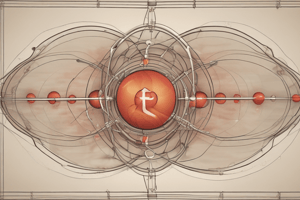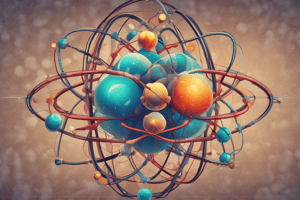Podcast
Questions and Answers
What is electron configuration, and how is it written?
What is electron configuration, and how is it written?
Electron configuration is a shorthand way to show the arrangement of electrons in an atom. It is written in the order of increasing energy levels (1s, 2s, 2p, 3s, 3p, etc.) with the number of electrons in each energy level indicated by a superscript.
How are positive ions formed?
How are positive ions formed?
Positive ions (cations) are formed when an atom loses one or more electrons.
What are covalent bonds, and how are they formed?
What are covalent bonds, and how are they formed?
Covalent bonds are formed when two or more atoms share one or more pairs of electrons.
What are the properties of metals?
What are the properties of metals?
The formula for calcium carbonate is Ca______
The formula for calcium carbonate is Ca______
Match the following types of chemical reactions with their descriptions:
Match the following types of chemical reactions with their descriptions:
What is a precipitation reaction?
What is a precipitation reaction?
How can you identify a precipitate in a precipitation reaction?
How can you identify a precipitate in a precipitation reaction?
What is the purpose of balancing an equation?
What is the purpose of balancing an equation?
Acids donate H+ ions in solution. Bases accept H+ ions in solution.
Acids donate H+ ions in solution. Bases accept H+ ions in solution.
What are hydrocarbons?
What are hydrocarbons?
Flashcards are hidden until you start studying
Study Notes
Electron Configuration of Neutral Atoms and Ions
- Electron configuration is a shorthand way to show the arrangement of electrons in an atom
- It is written in the order of increasing energy levels (1s, 2s, 2p, 3s, 3p, etc.)
- The number of electrons in each energy level is indicated by a superscript
- For neutral atoms, the number of electrons is equal to the atomic number
- For ions, the number of electrons is different from the atomic number due to gain or loss of electrons
Formation of Positive and Negative Ions
- Positive ions (cations) are formed when an atom loses one or more electrons
- Negative ions (anions) are formed when an atom gains one or more electrons
- The number of electrons lost or gained is indicated by the charge on the ion
- For example, Na (sodium) loses one electron to form Na+ (sodium ion), and Cl (chlorine) gains one electron to form Cl- (chloride ion)
Formation of Covalent and Ionic Bonds
- Covalent bonds are formed when two or more atoms share one or more pairs of electrons
- Ionic bonds are formed when one or more electrons are transferred from one atom to another
- Covalent bonds typically form between non-metal atoms, while ionic bonds typically form between metal and non-metal atoms
Properties of Metals
- Metals are typically shiny, malleable, and good conductors of electricity
- They tend to lose electrons to form positive ions
- Reactivity of metals increases as you move down a group in the periodic table
Writing Formulas using Data Booklet
- The formula of a compound is written using the symbols of the atoms involved and the ratio of atoms in the compound
- The data booklet provides the atomic numbers and symbols of elements
- For example, the formula for calcium carbonate is CaCO3, where Ca is calcium, C is carbon, and O is oxygen
Types of Chemical Reactions
- Chemical reactions involve the transformation of one or more substances into new substances
- Types of chemical reactions include:
- Synthesis reaction: two or more substances combine to form a new substance
- Decomposition reaction: a single substance breaks down into two or more substances
- Replacement reaction: one substance replaces another substance in a compound
- Combustion reaction: a substance reacts with oxygen to produce heat and light
Precipitation Reactions
- A precipitation reaction is a type of reaction where two solutions react to form an insoluble solid (precipitate)
- The precipitate can be identified by its colour, shape, and solubility
- For example, the reaction between silver nitrate and sodium chloride solutions produces a white precipitate of silver chloride
Balancing Equations
- A balanced equation is a chemical equation where the number of atoms of each element is equal on both the reactant and product sides
- The equation is balanced by adding coefficients (numbers) in front of the formulas of the reactants and products
Acids and Bases
- Acids are substances that donate H+ ions (hydrogen ions) in solution
- Bases are substances that accept H+ ions in solution
- The difference between acids and bases is the presence of H+ ions
- Neutralisation reaction: an acid reacts with a base to form a salt and water
Hydrocarbons
- Hydrocarbons are compounds that contain only hydrogen and carbon atoms
- They can be identified by their molecular formula and structural formula
- For example, methane (CH4) is a hydrocarbon with a molecular formula of CH4 and a structural formula of H-C-H-H-H
- Hydrocarbons can be drawn using dashes and wedges to represent the bonds between atoms
Electron Configuration
- Electron configuration is a shorthand way to show the arrangement of electrons in an atom, written in the order of increasing energy levels (1s, 2s, 2p, 3s, 3p, etc.)
- The number of electrons in each energy level is indicated by a superscript
- For neutral atoms, the number of electrons is equal to the atomic number
- For ions, the number of electrons is different from the atomic number due to gain or loss of electrons
Formation of Ions
- Positive ions (cations) are formed when an atom loses one or more electrons
- Negative ions (anions) are formed when an atom gains one or more electrons
- The number of electrons lost or gained is indicated by the charge on the ion
Formation of Bonds
- Covalent bonds are formed when two or more atoms share one or more pairs of electrons
- Ionic bonds are formed when one or more electrons are transferred from one atom to another
- Covalent bonds typically form between non-metal atoms, while ionic bonds typically form between metal and non-metal atoms
Metals
- Metals are typically shiny, malleable, and good conductors of electricity
- They tend to lose electrons to form positive ions
- Reactivity of metals increases as you move down a group in the periodic table
Writing Formulas
- The formula of a compound is written using the symbols of the atoms involved and the ratio of atoms in the compound
- The data booklet provides the atomic numbers and symbols of elements
Chemical Reactions
- Chemical reactions involve the transformation of one or more substances into new substances
- Types of chemical reactions include:
- Synthesis reaction: two or more substances combine to form a new substance
- Decomposition reaction: a single substance breaks down into two or more substances
- Replacement reaction: one substance replaces another substance in a compound
- Combustion reaction: a substance reacts with oxygen to produce heat and light
Precipitation Reactions
- A precipitation reaction is a type of reaction where two solutions react to form an insoluble solid (precipitate)
- The precipitate can be identified by its colour, shape, and solubility
Balancing Equations
- A balanced equation is a chemical equation where the number of atoms of each element is equal on both the reactant and product sides
- The equation is balanced by adding coefficients (numbers) in front of the formulas of the reactants and products
Acids and Bases
- Acids are substances that donate H+ ions (hydrogen ions) in solution
- Bases are substances that accept H+ ions in solution
- The difference between acids and bases is the presence of H+ ions
- Neutralisation reaction: an acid reacts with a base to form a salt and water
Hydrocarbons
- Hydrocarbons are compounds that contain only hydrogen and carbon atoms
- They can be identified by their molecular formula and structural formula
- Hydrocarbons can be drawn using dashes and wedges to represent the bonds between atoms
Studying That Suits You
Use AI to generate personalized quizzes and flashcards to suit your learning preferences.




